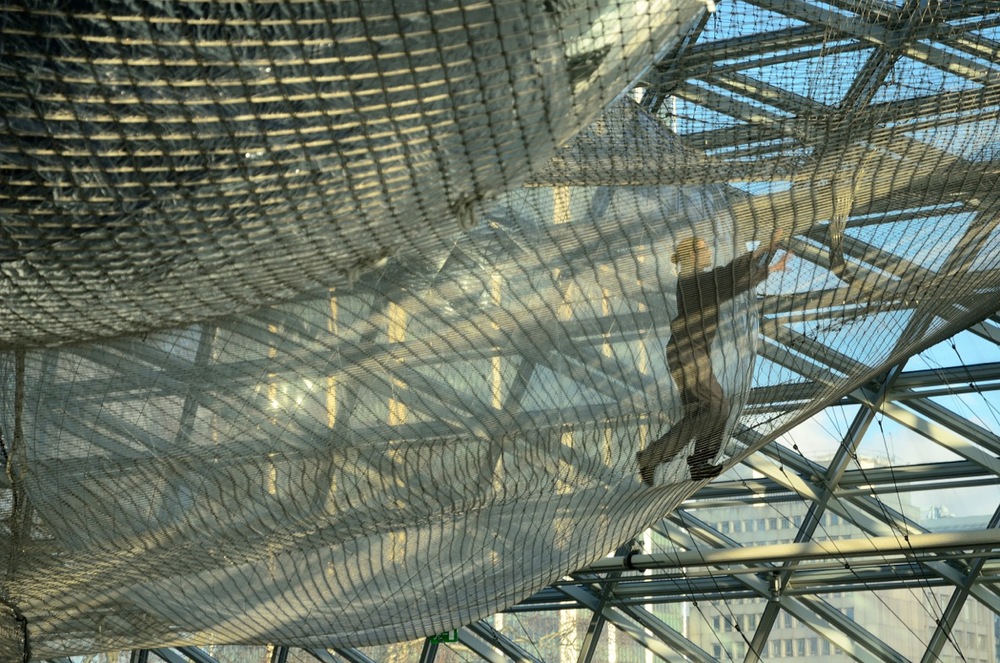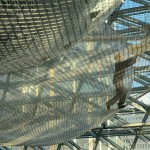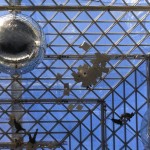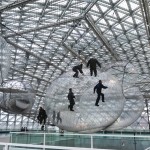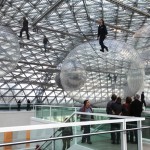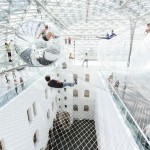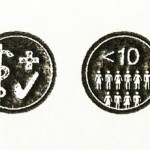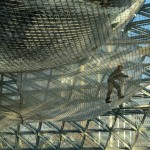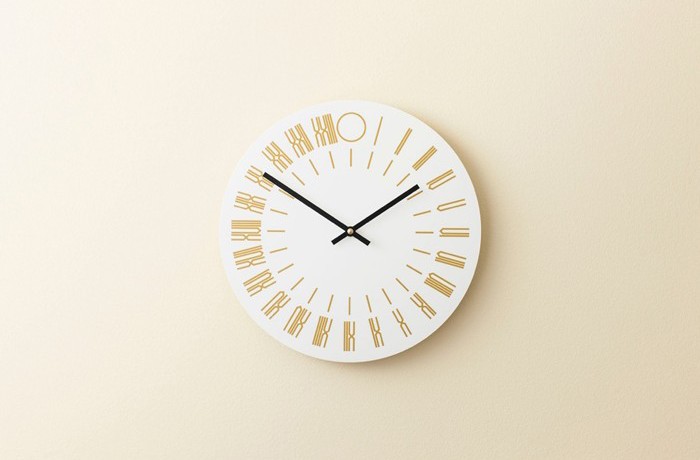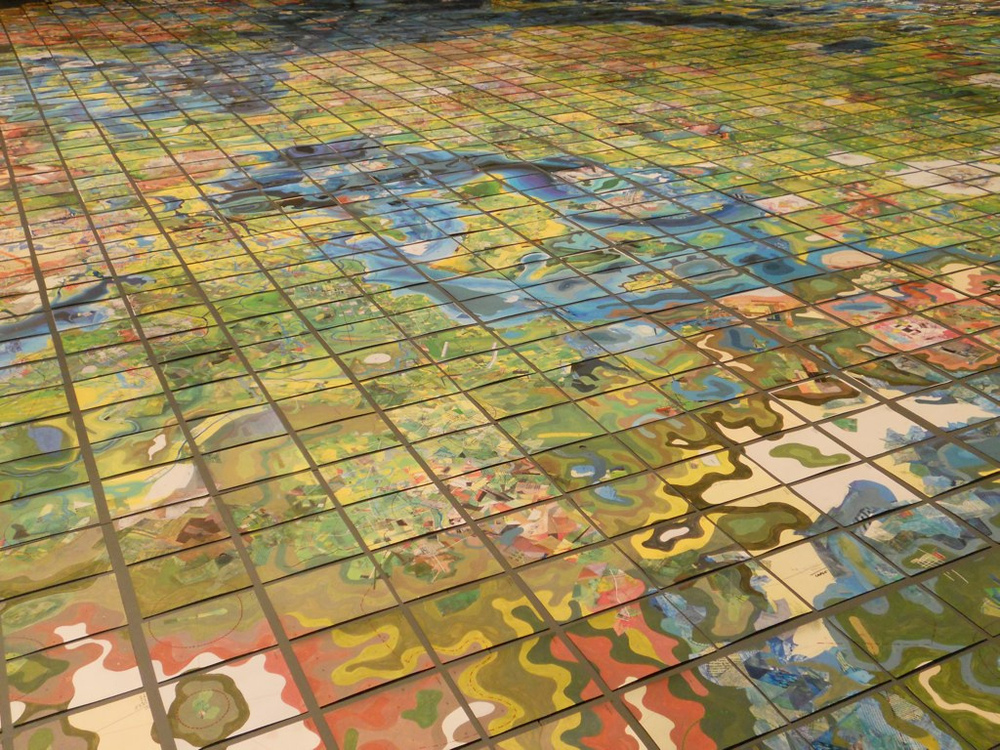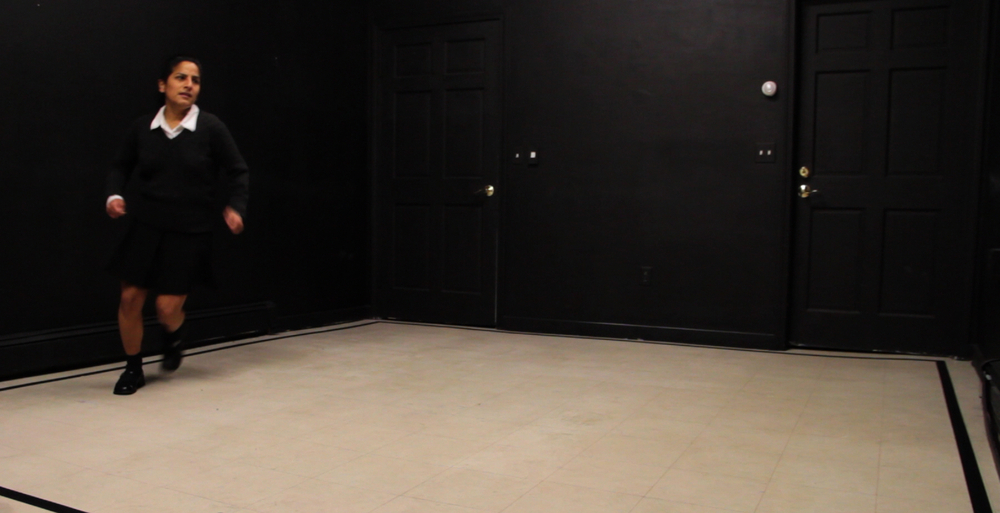In spite of my own fear of heights, I leap at the opportunity to participate in this work. After emptying my pockets, donning borrowed treaded sneakers and a jumpsuit, and receiving some brief safety instructions (in German and English), I eagerly climb the steps that lead up to the installation. Looking down, I observe how the piece consists of several layers of netting and in addition to the inflated spheres, there are several "rest" points made up of pillows. Initially, the distance between the net and solid ground is minimal as it is suspended over protruding gallery wings and stairwells. As I move further out into the installation, I find myself looking down onto the ground floor of the piazza five stories below. The net vibrates as other participants move through it, rattling my already fragile nerves. For me, this experience evokes an adrenaline surge of panic, as I am uncertain if I will be able to overcome my acrophobia. After some serious internal negotiation and conscious rationalization—this structure must be safe according to various protocols, or else untrained people will not be able to climb it—I take a deep breath, ignore my sweaty palms and growing feeling of nausea, and step further out onto the metal mesh. The sense of anxiety gives way to excitement as I crawl over to a small opening that leads to an upper level. Once I reach this point and take a brief rest on a comfortable pile of pillows, my heart still pounding, I realize that I have never had an aesthetic experience quite like this one. I commonly hear people refer to art works as "thrilling," though this is a metaphoric thrill that comes from the excitement evoked by concepts and forms, and not the literal adrenaline-fuelled rush aroused by in orbit. Saraceno describes how the work is meant to induce emotions of fear and desire associated with heights: "to describe the work means to describe the people who use it—and their emotions."1 In my experience, in orbit opens up a Spielraum, or "room-for-play," that offers spectators the opportunity to test emotional and physical limits. Additionally, I consider this work to be more than a physical installation, as it encompasses a performance event where the spectators become performers vital to the successful execution of the work. This reading unpacks the artist’s utopian impulse, contributing an alternative understanding of in orbit that is not confined to futuristic ideals.
Spielraum translates from German into "playroom." In everyday German usage, the Spielraum functions as conceptual "elbow room," or a space of discursive negotiation. Martin Heidegger uses the term in his essay "The Origin of the Work of Art" in reference to the revealing of "truth":
Truth happens only by establishing itself in the strife and the free space [Streit- und Spielraum] opened up by truth itself. Because truth is the opposition of clearing and concealing, there belongs to it what is here to be called establishing [emphasis in original].2
According to Heidegger, the work of art makes space for alethia, or the "unconcealment" of "truth," to occur. Samuel Weber reads Heidegger's definition of the work of art as breaking from classical aesthetics that treats the artwork as self-contained: "rather, it is a work repeatedly designated as a Spielraum, a play-room, but also . . . a stage of conflict and dispute."3 Weber describes how the Spielraum exists as a place of play, or free space, but this play is not harmonious. The Spielraum is a place of negotiation, of conflict, of dissensus, of experimentation—of strife and play.
Walter Benjamin also explores the concept of Spiel, or play, and Spielraum. Miriam Bratu Hansen describes how the term appears in various instances of Benjamin’s writing, most explicitly his book reviews and exhibition reports on children’s toys from 1928. According to Hansen, "In these articles he argues for a shift in focus from the toy as object [Spielzeug] to playing [Spielen] as an activity, a process in which, one might say, the toy functions as a medium."4 As such, this opens a space of play for a child to engage in actions not intended by or necessarily understood by adults. Hansen points out how the concept of play returns in Benjamin’s work in other ways, including the association of Spiel to mimetic play, as when children mimic adult actions, and gambling.5
Hansen emphasizes how Benjamin’s use of "play" is part of a larger philosophical genealogy that can be traced to Karl Groos, Willy Haas, and most importantly, Sigmund Freud’s 1920 essay Beyond the Pleasure Principle.6 Here Freud considers the role of infantile play, particularly, the "fort/da game," in relation to traumatic neurosis. He states: "As the child passes over from the passivity of the experience to the activity of the game, he hands on the disagreeable experience to one of his playmates and in this way revenges himself on a substitute."7 Thus, according to Freud, play can potentially transform painful experiences into pleasurable ones, establishing a relationship between strife and play. Benjamin later translates this concept into his discussion of cinema where he uses the term Spielraum, which Hansen argues must be read in "both its literal and figurative, material and abstract meanings."8 In correlation with Freud’s treatment of play as a means to make painful experiences pleasurable, Hansen points out how for Benjamin, the Spielraum could help ease the "traumatic effects of the bungled reception of technology" in the early twentieth century.9
In terms of in orbit, the material form of the installation opens up space for strife and play where spectators are welcome to test their limits as they strategically move throughout the net—a suspended Spielraum. There are no directed courses or linear projections that determine where each participant needs to move. Additionally, the layers of the net offer various psychological reassurances that can inform where and how a participant negotiates the space. In my experience, I relished in the thrill of being suspended over a single net high above the museum piazza—but only after I let a fellow participant scope out the route first. As I carefully walk along the net, I try suppressing my beating heart and heavy breathing as I challenge feelings of vertigo. This battle between rational thought and automatic nervous responses enhances my excitement as I trek along my course while confronting my fears and anxieties. These experiences of strife and play literally leave me breathless when I finally exit the installation.
These emotional qualities are not inherent to the material properties of the work, but are only produced through audience participation. Therefore, I read this work as a performance event focusing on the role of the spectator’s body. The performances of in orbit operate in a feedback loop, or what Erika Fischer-Lichte refers to as autopoetic systems that are "simultaneously producers and products, circular systems that survive by self-generation."10 Here, art is treated as an event and self-organizing system that "continually receives and integrates into that system newly emerging, unplanned, and unpredictable elements from both sides of the loop."11 A participant takes a step, which sends a course of vibrations to another participant. This opens up a range of potential responding activities for the second participant—try to secure more comfortable footing, move to a less mobile part of the net, seek out companionship and reassurance with a familiar face, or stubbornly forge ahead—whose motions and actions further move the materials and continue the chain reaction. Fischer-Lichte emphasizes the interactions of participants in a performance, which "are generated and determined by a self-referential and ever-changing feedback loop. Hence, performance remains unpredictable and spontaneous to a certain degree."12 It is these relationships and how the participants respond to the materials and formal parameters of the work that contribute to in orbit’s successful activation. The ability of the piece to evoke an emotional depth from the spectators is noted in the museum’s description of the work: "[in orbit] zeroed in so directly on the emotional lives—the fears and desires—of beholders or intervened with such immediacy into the experiences of those who expose themselves to adventure."13 Saraceno asks his audience to test their limits and exist in an alternative sphere of being, if only for a short period of time.
Nicolas Bourriaud popularized the critical significance of art works dependent on audience participation in his 1990’s book, Relational Aesthetics. In this text, he claims that the visual arts at the turn of the twentieth century offer something different for the audience. Instead of aspiring for drastic social changes and functioning as revolutionary impetus, the relational characteristics of this art open up "micro-utopias" based on everyday situations and interactions.14 Some of the works Bourriaud discusses include the shared Thai dinners of Rirkrit Tiravanija and the stacks of candy or paper placed in galleries by Felix Gonzalez-Torres for audience members to remove one-by-one. Bourriaud claims "utopia is being lived on a subjective, everyday basis, in the real time of concrete and intentionally fragmentary experiments."15 in orbit offers audience members the immersive experience consistent with the works Bourriaud describes, but Saraceno’s utopian impulse also returns the idealistic grand gestures that relational aesthetics intends to forgo.
in orbit constitutes part of Saraceno’s greater ambitions—a utopian project called "Air-Port-City," which is a floating city of the future.16 Commissioned photographs of in orbit are reminiscent of utopian architecture and portray an idealized version of how the work is meant to function. Richard Noble describes how "most utopian art postulates models of other ways of being."17 Noble goes on to characterize two major qualities of utopian art: first of all, artworks need to offer a vision or model of place or way of being different from what we now inhabit; secondly, these works need to reference the "contradictions and limitations that drive our will to escape the here and now in the first place."18 In other words, the utopian is meant to offer something "better" than what is already present. in orbit fulfills both of these criteria. It presents Saraceno’s vision of a floating city by offering participants a different means of occupying a place. Also, being in the net offers an alternative perspective for experiencing the world while potentially evoking emotional tension and contradictions in the participant. As an installation, the work is more than just a digital rendering or scaled-down model that characterizes some utopian architecture; rather, it offers an opportunity for the spectator to confront the limitations of our current state of being in relationship to physical place. By occupying a liminal part of the museum—right below the dome—Saraceno offers an alternative means of moving through the building. He lets us move in a suspended state of animation, sparking the futuristic imagination and Science Fiction daydreams—think hover cars and jet packs. As New York Times art critic Roberta Smith points out: "his work optimistically predicts a future when people will live above the earth in mutating, cloudlike cities, free of the tensions of nationalism."19
However, the notion of "utopia" needs to be unpacked. The "better worlds" that utopias offer are not universal, but rather, are culturally contingent—based on the historical and cultural contexts within which they are produced as well as the aspirations of the thinker. Limiting readings of Saraceno’s work to his utopian goals reduces its critical scope and other potential readings. This has resulted in criticisms like Liz Else’s response to the artist: "Does Tomás Saraceno just want to float away altogether?"20 It may be easy to become enraptured with the idealist implications of Saraceno’s artworks and the massive collaborative efforts involved in their creation, which Smith refers to when she states:
It can be interesting to read about Mr. Saraceno’s art, especially the incredible effort involved in realizing it, but as you read quotations from his highly knowledgeable, skilled, enthusiastic collaborators, the works also assume a too-big-to-fail aspect. Too many people enjoy working on, bouncing on and navigating these things. They must be good.21
These qualities constitute the seduction of utopia that allows gestures of betterment to unfold as imperialist compulsions. Saraceno’s desire to create a floating city free from tension and conflict tied with national boundaries has noble connotations, but this idealism comes across as neoliberal pining. The actual experience of being in the net does not necessarily resonate with these sentiments. Crawling along the metal mesh, exploring the museum from a suspended perspective, and testing the limits of fear and anxiety offer valuable opportunities for the spectator, but are a far cry from the idealized vision of the artist’s utopian goal. This underscores some of the Fredric Jameson’s reconsideration of utopia—where emphasis is not placed on the "perfect world" it offers, but the process of imagining associated with it.22
Additionally, the participant of Saraceno’s in orbit is not a completely free subject. In conjunction with the potential personal reservations noted in this article, including the physical and emotional anxieties associated with moving at great heights, the installation has a number of institutional regulations that limit the freedoms of participants. Participants are required to sign a waiver and review safety regulations, wear special jumpsuits provided by the museum (screen painted with the name of the work on the back), and are prevented from bringing any personal belongings into the net. Even though these restrictions are presented with the intent of maintaining the safety of participants and people below the net, as such, this "utopian" space never escapes the procedures and regulations of the society within which is exists.
My alternative reading of in orbit treats the work as a Spielraum that focuses on the bodily experiences of audience members while present in the installation. Emphasizing these qualities allow for the work to be read as a performance event where room for strife and play unfolds. While the project may participate as part of Saraceno’s vision for creating new realities, instead of restricting its significance to a utopian "no place," it can be read as a concrete site of physical, emotional, and aesthetic engagement.
- Tomás Saraceno, in orbit, 2013. Photograph of EL Putnam in the installation.
- Tomás Saraceno, in orbit, 2013. View from the ground. Photograph by EL Putnam.
- Tomás Saraceno, in orbit, 2013. Photograph by EL Putnam.
- Tomás Saraceno, in orbit, 2013. Photograph by EL Putnam.
- Tomás Saraceno, in orbit, 2013. Photograph by Studio Tomás Saraceno ©2013.
- Some of the institutional safety restrictions and regulations for in orbit. From Left to Right: minimum age for participation is 12; treaded footwear is required; participants must be in good health; no more than 10 participants allowed in the net at one time; during peak periods, time in net is limited to 10 minutes; empty all pockets before entering the net.
- Tomás Saraceno, in orbit, 2013. Photograph of EL Putnam in the installation.
[1] As quoted in "Tomás Saraceno," K21 Ständehaus, http://www.kunstsammlung.de/en/discover/exhibitions/tomas-saraceno.html.
[2] Martin Heidegger, "The Origin of the Work of Art," in Basic Writings, ed. David Farrell Krell (London: Harper Perennial Modern Thought, 2008), 186.
[3] Samuel Weber, Theatricality as Medium, (New York Fordham University Press, 2004), Kindle edition, 64.
[4] Miriam Bratu Hansen, "Room-for-Play: Benjamin's Gamble with Cinema," October 109, Summer (2004): 6.
[5] Ibid. 8.
[6] Ibid. 11.
[7] Sigmund Freud, "Beyond the Pleasure Principle," in The Freud Reader, Peter Gay ed., (New York and London: W.W. Norton & Company, 1989), 601.
[8] Hansen, "Room-for-Play," 20.
[9] Ibid. 29.
[10] Carlson, "Perspectives on Performance," 7.
[11] Ibid. 8.
[12] Fischer-Lichte, The Transformative Power of Performance, 38.
[13] "Tomás Saraceno."
[14] Nicolas Bourriaud, Relational Aesthetics (Dijon, France: Les presses du réel, 2009), 31.
[15] Ibid. 45.
[16] "Tomás Saraceno."
[17] Richard Noble, "Introduction: The Utopian Impulse in Contemporary Art," in Utopias, ed. Richard Noble(London and Cambridge, MA: Whitechapel Gallery and MIT Press, 2009), 14.
[18] Ibid.
[19] Roberta Smith, "Climbing into the Future, or Just into an Artist's Whimsy," New York Times, May 25 2012.
[20] Liz Else, "Review: Radical Nature: Art and Architecture for a Changing Planet," New Scientist 203, no. 2721 (2009): 42.
[21] Smith, "Climbing into the Future, or Just into an Artist's Whimsy."
[22] See Fredric Jameson, Archaeologies of the Future: The Desire Called Utopia and Other Science Fictions (London and New York: Verso, 2007).

